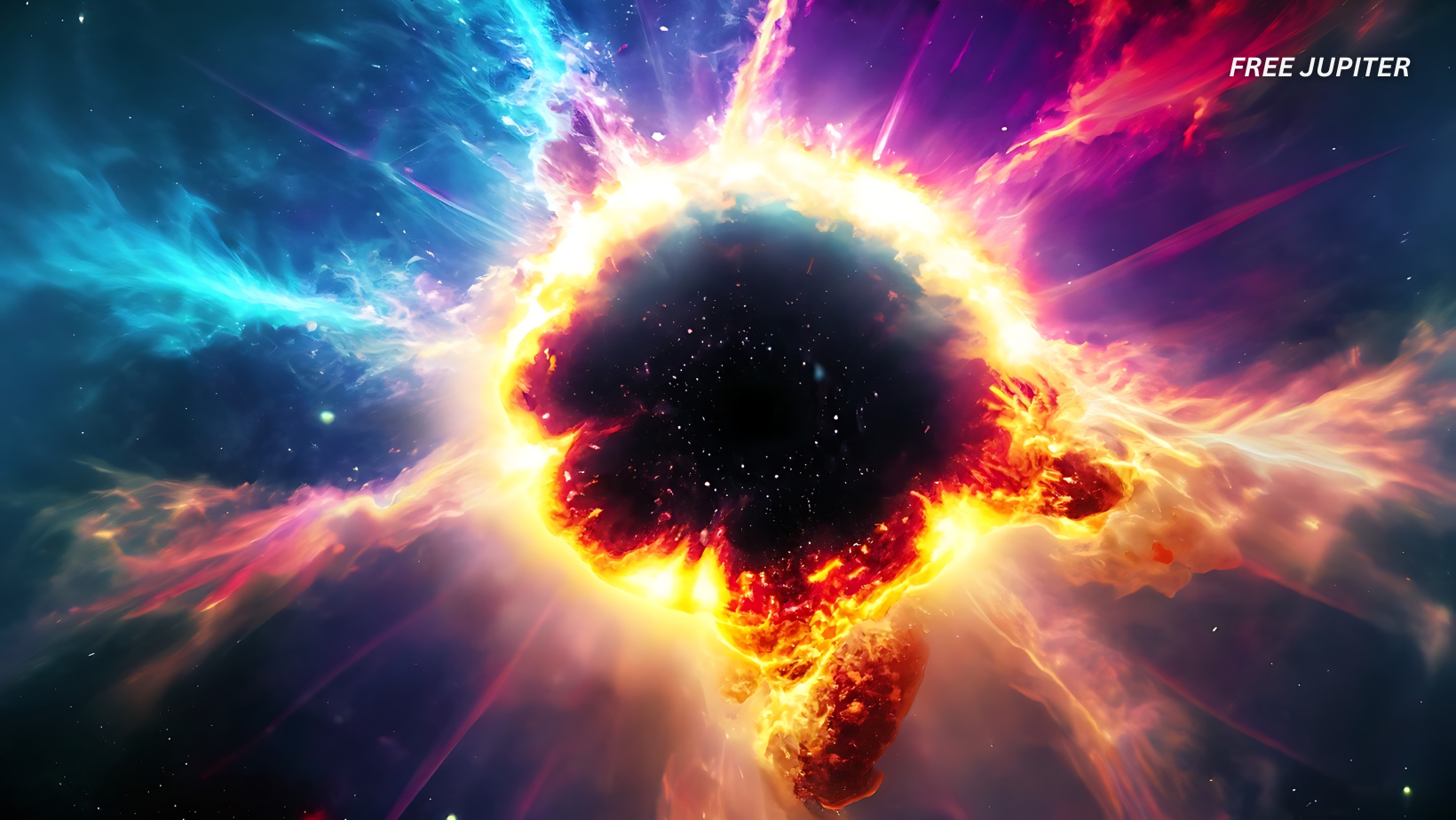Friendly Note: FreeJupiter.com shares general info for curious minds 🌟 Please fact-check all claims—and always check health matters with a professional 💙
In the ever-expanding vault of cosmic wonders, scientists have just opened the door to a new and astonishing chapter. Astronomers have recently identified some of the most powerful explosions the universe has seen since the colossal birth event known as the Big Bang.
These eruptions, dubbed extreme nuclear transients (ENTs), shine with an intensity that boggles even the most seasoned stargazers.
This newly recognized class of cosmic event has been spotted in three separate galaxies, all situated far beyond our cosmic backyard. Each of these galactic centers is home to a supermassive black hole, and each one has taken part in an incredibly violent act — the dismemberment of an oversized star that wandered too close.
As the black hole tore the star apart, it ignited an astonishing flare of energy that outshone entire galaxies.
But unlike ordinary supernovae — those brilliant bursts that light up for a short while before fading back into darkness — these ENTs take their time. Months pass before they even reach peak brightness, and years can go by before they fully dim.
One such eruption, identified as Gaia18cdj, managed to radiate more energy in just a single year than what 100 suns would produce over their entire lifespans.
Long Glow, Deep Insights
The reason these celestial eruptions are turning heads isn’t just their sheer scale. Their longevity makes them invaluable tools for astrophysics. Because ENTs maintain visibility for such extended periods, astronomers can study them from across enormous distances — effectively peering into epochs of the universe previously inaccessible.
Jason Hinkle, the astronomer who first noticed these oddities while combing through data from the now-retired Gaia space observatory, recalled being struck by just how extreme these events were. “From the beginning, there was a clear sign that we were dealing with something truly exceptional in terms of power,” he noted.
The events are so bright and durable that they help researchers unlock insights about the early universe, offering a glimpse into the most energetic environments in cosmic history.
According to Anna Payne, a researcher at the Space Telescope Science Institute, these observations are challenging the upper thresholds of what scientists understand about cosmic violence. “We are pushing the envelope on what constitutes the most energetic regions in the universe,” she remarked.
Read more:Experts Say ‘Time Mirrors’ Are Actually A Real Thing: ‘Like Pressing Undo On The Universe’
A New Kind of Catastrophe
The seeds of this discovery were planted in 2020 when Hinkle, then sifting through a mountain of telescope data, found two peculiar signals. These unusually luminous and long-lasting flashes had originally been recorded in 2016 and 2018.
Then came 2023, and with it, the discovery of a third, equally puzzling event. This one was flagged by the Zwicky Transient Facility (ZTF), an observatory dedicated to catching brief cosmic phenomena. This specific event carried the technical name ZTF20abrbeie, but earned the informal and unforgettable nickname “Scary Barbie.”
With three of these events now on record, it became increasingly clear to Hinkle and colleagues that they were not looking at isolated cosmic quirks. Instead, these powerful flares appeared to belong to a previously unrecognized category of stellar destruction.
“It all suddenly made sense,” Hinkle recalled. “This wasn’t random — we were seeing a brand-new class of phenomenon.”
A Multi-Eye Investigation
Once the suspicion arose that these outbursts represented a new kind of celestial event, a coordinated observational effort was launched. Multiple observatories, each with unique capabilities, worked in tandem to uncover the secrets behind these galactic flares.
Among the key contributors was NEOWISE, a NASA infrared mission that had initially been designed to hunt for near-Earth asteroids. Though it is now retired, NEOWISE played a vital role in helping map the dust around these ravenous black holes, shedding light on the environments in which the events occurred.
Another essential player was the Neil Gehrels Swift Observatory, which brought data from ultraviolet and X-ray spectrums to the table. By examining how light in various wavelengths surged and faded, researchers built a signature profile — a cosmic fingerprint, if you will. That profile closely matched what physicists would expect to see when a black hole disintegrates a star.
The distinctive light curves and energy distribution helped rule out other potential culprits such as standard supernovae or more familiar black hole activities. The evidence became overwhelming: these were truly unique events powered by colossal black holes feasting on massive stars.
Read more: Researchers Say That The Universe May End Sooner Than We Thought
A Glimpse into the Distant Past
With the identification of these first few ENTs, astronomers now have a powerful new tool for cosmic exploration. These dazzling explosions don’t just light up the sky — they illuminate the evolution of galaxies and black holes across billions of years.
Researchers hope that these discoveries will guide upcoming astronomical surveys in locating even more of these rare phenomena. The more examples scientists can catalog, the better they can map the dynamics of galactic cores, particularly those hiding dormant black holes.
One of the most anticipated tools in this effort is NASA’s Nancy Grace Roman Space Telescope. Scheduled for launch in 2027, this observatory boasts high infrared sensitivity, allowing it to potentially detect ENTs that erupted more than 12 billion years ago, close to the universe’s infancy. However, the mission’s timeline remains uncertain due to ongoing budgetary discussions.
Another promising player is the Vera C. Rubin Observatory in Chile. It’s gearing up to conduct the Legacy Survey of Space and Time (LSST), an ambitious project aimed at scanning large portions of the sky with unprecedented depth and frequency. This survey could uncover a treasure trove of ENTs, offering detailed data on how these explosions vary in size, duration, and structure.
Hinkle believes these future efforts could unravel even more layers of complexity within this newly discovered cosmic category. “The universe has a way of surprising us,” he said. “There’s probably a whole range of variations we haven’t begun to recognize yet.”
Why These Events Matter
Beyond their shock value, ENTs could fill in significant blanks in our cosmic history. Their extreme brightness enables them to serve as beacons from the distant past, carrying information across billions of light-years. This allows scientists to examine what galaxies and black holes were like shortly after the Big Bang — at a time when the first structures in the universe were forming.
And because ENTs are tied directly to black holes, they offer a rare opportunity to observe one of the most enigmatic phenomena in all of physics. Black holes themselves cannot be seen directly, but events like these betray their presence in spectacular fashion.
They also provide insights into how stars live — and how they die — when subjected to the gravitation of these monsters. It’s a window not only into destruction but into the complex choreography that governs the universe.
Read more: Scientists May Have Located the “Missing Half” Of Universe’s Matter
Conclusion: A Frontier Just Unfolding
The discovery of extreme nuclear transients signals more than just another headline-worthy cosmic event. It marks the beginning of a new chapter in observational astronomy, one where some of the universe’s most secretive and energetic events are finally coming into focus.
As new instruments come online and astronomers refine their methods, it’s likely that we’ve only just scratched the surface of what these galactic juggernauts can teach us. Somewhere in the silent expanse, more stars are being shredded by invisible giants — and their dazzling deaths are already racing toward our telescopes.










